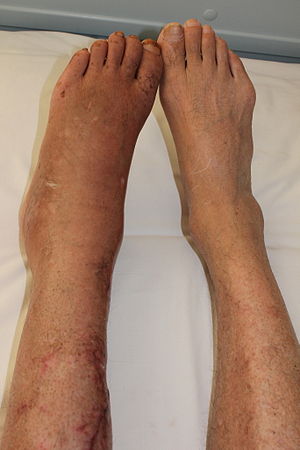Complex Regional Pain Syndrome
| Complex regional pain syndrome | |
|---|---|
| Synonyms | reflex sympathetic dystrophy (RSD), causalgia, reflex neurovascular dystrophy (RND) |
 |
|
| Complex regional pain syndrome | |
| Classification and external resources | |
| Specialty | Neurology |
| ICD-10 | M89.0, G56.4 |
| ICD-9-CM | 337.21, 337.22, 354.4, 355.71 |
| DiseasesDB | 12635 16345 |
| MedlinePlus | 007184 |
| eMedicine | pmr/123 |
| Patient UK | Complex regional pain syndrome |
| MeSH | D020918 |
Complex regional pain syndrome (CRPS), also known as reflex sympathetic dystrophy (RSD), is a long term condition that often worsens with time. It is characterized by severe pain and sensitivity, swelling, and changes in the skin. It may initially affect one limb and then spread throughout the body; 35% of people affected report symptoms throughout their whole body.
The cause of CRPS is unknown though CRPS is associated with dysregulation of the central nervous system and autonomic nervous system resulting in multiple functional loss, impairment and disability. Precipitating factors include injury and surgery, although there are cases where no injury had occurred at the original site. CRPS is not caused by psychological factors, yet the constant pain and reduced quality of life has been known to cause psychological problems (such as increased depression and anxiety). Although "research does not reveal support for specific personality or psychopathology predictors of the condition," CRPS is associated with psychosocial effects, including impaired social and occupational function. It is classified as an amplified musculoskeletal pain syndrome.
Treatment is complicated, involving medications, physical and occupational therapy, psychological treatments, and neuromodulation and is often unsatisfactory, especially if delayed.
Clinical features of CRPS have been found to be neurogenic inflammation, nociceptive sensitisation, vasomotor dysfunction, and maladaptive neuroplasticity. The symptoms of CRPS usually initially manifest near the site of a (typically minor) injury. The most common symptoms are pain sensations, including burning, stabbing, grinding, and throbbing. Moving or touching the limb is often intolerable. The patient may also experience muscle spasms; local swelling; extreme sensitivity to things such as wind and water, touch and vibrations; abnormally increased sweating; changes in skin temperature (usually hot but sometimes cold) and color (bright red or a reddish violet); softening and thinning of bones; joint tenderness or stiffness; changes in nail and hair growth and/or restricted or painful movement. Drop attacks (falls), pre-syncope, and syncope (fainting) are infrequently reported, as are visual problems. The symptoms of CRPS vary in severity and duration. Since CRPS is a systemic problem, potentially any organ can be affected.
...
Wikipedia
